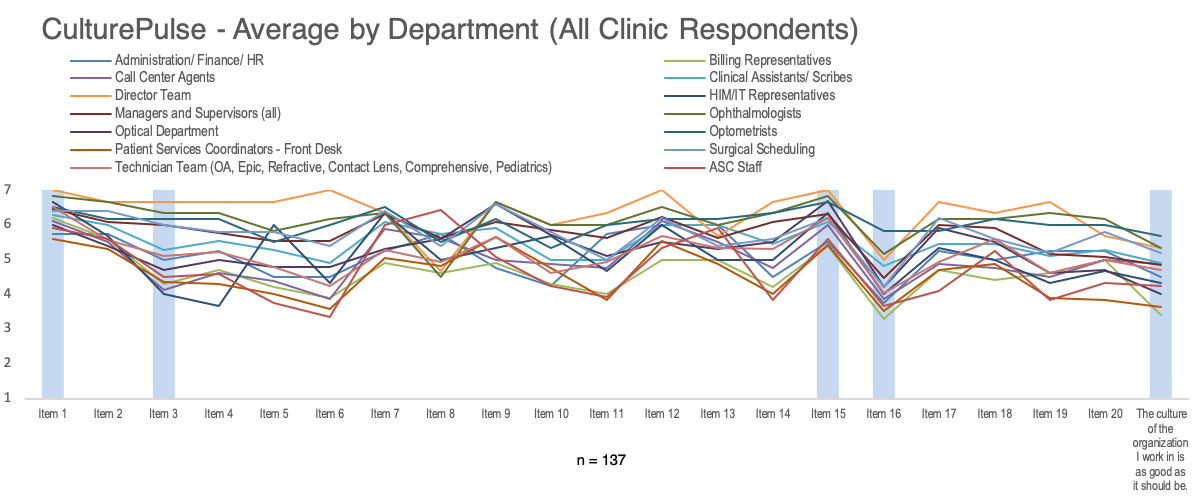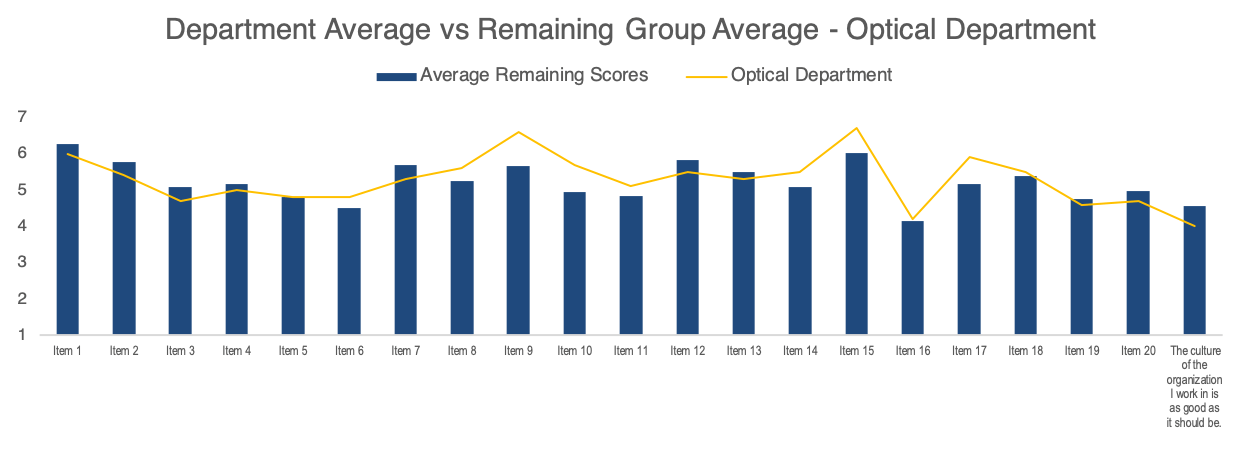Setting: A comprehensive, multi-site adult and pediatric medical and surgical eye care center.
Specific leadership development coaching opportunity: Head of retail optical services; eyeglasses and contact lens sales and service. Sales and service provided with each clinic site.
Purpose of coaching opportunity: Organizational strategy calls for a higher level of optical services integration with the overall eye health mission and care model to improve the quality of care, the patient experience and loyalty, and the financial performance of the organizational strategy.
Coaching process initiation: The first session follows the administration of the CulturePulse to staff in all clinical services and administrative departments. Full summary results are presented to staff at an all-staff meeting. Follow-up sessions held with each department leader to provide department-specific results and to initiate a “coaching to culture” leadership development plan.
Leadership development plan:The organization’s mission is “Vision for a Lifetime.” Medical and surgical eye care is provided to children, adolescents and adults. A key strategic goal of the organization is long-term patient relationships. The marketplace is crowded and competitive, with high-quality service providers. Optical services are especially competitive. Eye clinics that sell optical products can’t compete with on-line or shopping mall providers on price. The differentiator must be service and the patient experience. Competition for qualified staff is intense. Some patients are inclined to rate their experience with optical services as being more important than the “doctor visit.” The interaction with an optician, along with the overall quality of care, is critical to the patient experience.
Presenting the Leader with the results of the CulturePulse provided to all staff, all departments, all sites; August 2019:The purpose of the administration of the CulturePulse was reviewed with the leader of optical services, including the instrument’s theoretical framework, structure, and purpose. The organization’s mission, the current strategic plan, and goals were reviewed as well. The mission and the strategic links between clinical services programming and optical services were established, as defined in the organizational strategic plan (i.e., the experience with the clinics’ optical shops as an integrated component of a comprehensive patient experience.) There was a discussion on the optical services leader’s understandings of the “fit” and importance of the department he leads and the success of the organization’s mission and strategic plan. His initial observations of opportunities and challenges for achieving this goal were discussed. He understands the importance of optical services to the strategic plan.
Presentations of Summary Results; All CulturePulse Respondents:The leader was briefed on individual average item responses and meanings, including relationships of responses to the final culture evaluation item. Summary results and interpretations of all respondents were presented, including comparisons of response results overall and by department surveyed. (see figures A and B)
Figure A represents the average item responses for the total sample (the display with distributions of responses within items). Figure B is the average item responses by classification of respondents by department.
The five critical predictors of respondents’ evaluation of the organization’s culture being “as good as it should be” were presented. Summary for all respondents:
1) “Leaders collaborate effectively for the good of the organization.”
2) “Leaders are working to create an environment I can trust to be fair.”
3) “Every patient (customer) will receive the experience they expect and deserve.”
4) “I am proud to be associated with the organization.”
5) “When leaders make tough decisions, they are guided by the right values.
The leader shared his perspectives on how these key predictors of responses to the last item (“the culture of the organization is as good as it should be”) may relate to the role of day-to-day performance of optical services, including the challenges of personnel management, the customer experience and the perceived role of optical services as a component of the broader mission and strategy.
Figure A. Average Response Score

Figure B. Average Item Score by Department

In addition to the presentation and discussion of the five “key predictors,” a summary of the themes derived from the written responses to the last item were presented “the culture is as good as it should be”:
1) “Listen” to what we have to say; our opinions may be important.”
2) “Tell us where the organization is going.”
3) “Hold everyone to the same level of accountability.”
4) “We don’t behave like a unified company.”
5) “There are sub-cultures in the organization that are a problem.”
6) “Respect us for what we know.”
7) “Team is important.”
Next, the leader’s department results were presented; average item scores from the optical department with comparisons to item averages for all other departments. (see figure C).
Item comparisons were reviewed. The leader was asked to reflect on each in the context of the department’s role in the mission and strategy of the organization. The goal was for the leader to make real and practical connections between the results of the whole compared with those of the optical department.
Figure C. Average Item Score for Optical Department Members Compared to the Whole

Other key, related findings from the CulturePulse were added to the discussion. Key item results and patterns for consideration (all responses considered; see Figure B above):
1) Item #1; all staff surveyed seem clear on the mission and purpose of the organization.
2) Item #15; most respondents understand how their role in the organization “contributes to the mission and goals of the organization in a meaningful way.”
3) Item #16; “holding employees to the same level of accountability”; there is consensus on the importance of this factor across the work environment and all sites.
4) Item #18; “I’m working in the best place for me at this point in my career”; departmental item score averages at “4-7” on a seven-point scale.
5) Item #21; “the culture is as good as it should be”; 75% of average item scores, per department, above scale midpoint, (i.e., 4-7 range.)
The Leader’s Role Moving Forward; Agenda for Follow-Up Sessions and Leadership Development Plan; Next Three Months:The leader examines results on his own to develop a preliminary approach to connecting the performance goals of the department with the CulturePulse™ results and his initial thoughts on how to present the results and plan to all staff. The leader is assisted in preparing a presentation to the team, including the translation of findings to a plan for the department.
Assist leader with his plan to model the right behaviors, how to effectively integrate his leadership behaviors plan with the organizational performance plan, and how he works to align the attitudes and behaviors of individual staff members with the mission and strategic performance expectations for his department.
Develop a plan for the leader to integrate “culture behavior” performance evaluations with performance plans for supervisors and their direct reporters. In other words, integrate “culture behaviors” with routine employee performance evaluations.
Quarterly leadership development meetings are expected with the department leader providing progress with the plan and presenting his ongoing evaluation of his performance and leadership development requirements. The leader will reach out to referring doctors within the practice for their perspectives on effective integration of optical services with patient care plans.


